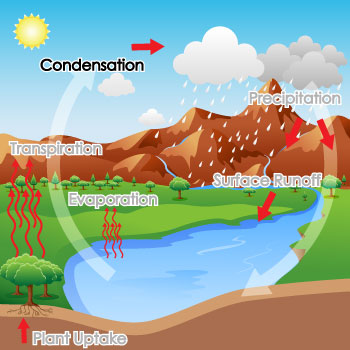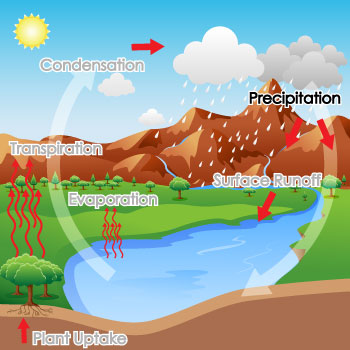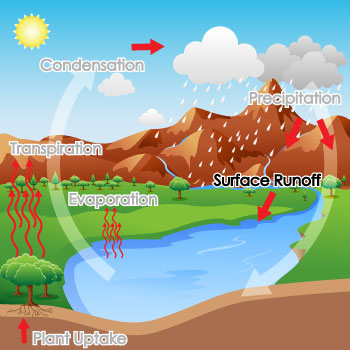If a biogeochemical cycle is the way in which a substance moves through an ecosystem, then the hydrologic, or water, cycle is arguably one of the most important, well known, and visible cycles. (Hydro- means "water." You can remember this by thinking about staying hydrated by drinking enough liquid.) In the hydrologic cycle, water moves from reservoir to reservoir in a constant flow. A reservoir is sometimes called a sink. It is a place in an ecosystem where a substance is collected. You may be familiar with the word reservoir as a source for water, but in ecology, it can be a storage place for any substance.
Click through the slides below to explore the major steps of the hydrologic cycle.
Evaporation
In any cycle, you must choose a first step. Water enters the earth's atmosphere by evaporation, which is the process in which a liquid turns into a gas (vapor). Water vapor also enters the atmosphere by transpiration, which is when water leaves a plant through its leaves. Condensation
As the water vapor rises into the atmosphere, it meets cooler temperatures which cause condensation--the formation of liquid from a gas. The liquid takes the shape of tiny droplets which are seen as clouds. Clouds rarely stay in one local ecosystem; weather patterns send clouds to different parts of the earth. Precipitation
As the condensed water droplets increase in size, they eventually fall from the sky in some form of precipitation. Rain is the most common form of precipitation, but some water falls to the ground as hail, snow, sleet, and ice. Runoff
The water that reaches the ground can take one of many pathways. Some of it will strike the ground, and run downhill by the force of gravity in a process called runoff into a nearby stream, lake, or river. From there, it will move to an ocean, which is the largest water reservoir in the world. Reentering the Cycle
Water constantly reenters the water cycle by evaporating from the ocean and other bodies of water. However, water that reaches the ground through precipitation may not necessarily join other larger bodies directly or through runoff. Some is absorbed by plants where it will eventually be used by the plant or reenter the cycle through transpiration. Some water will evaporate directly from the ground. Some water will soak deep into the ground (become groundwater) where it will be stored in an underground reservoir called an aquifer. And of course, some water will be used by humans and other animals. |
Understanding the hydrologic cycle means being able to use many new terms associated with water. Review these terms by matching them to their definitions.
|
precipitation
transpiration
condensation
runoff
evaporation
groundwater
|
process by which water leaves a plant through its leaves
process in which a liquid turns into a gas (vapor)
process in which a gas turns into a liquid
water that falls from the atmosphere to the ground
movement of water that falls on land to larger bodies of water
water held in soil or rock
|
Try again.
Question
Why is the hydrologic cycle so important to an ecosystem?





